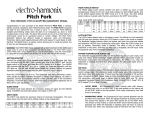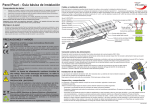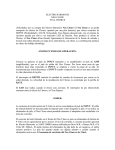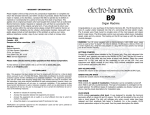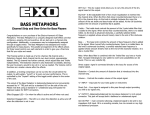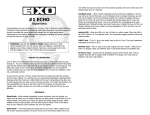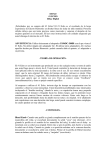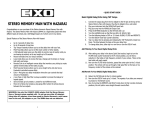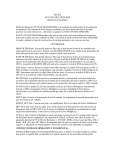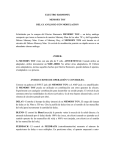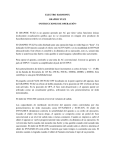Download superego - Gear4music
Transcript
SUPEREGO SYNTH ENGINE Congratulations on your purchase of the Electro-Harmonix SUPEREGO Synth Engine; a new and unique product that combines elements of sampling, synthesis and infinite sustain. The Superego allows the musician to freeze sound, gliss between frozen sounds, layer sounds and place an external effects loop on only the effect. In addition, the Superego can detect new notes or chords and sustain them automatically without requiring the musician to step on the footswitch. WARNING: Your Superego comes equipped with an Electro-Harmonix 9.6DC-200BI power supply (same as used by Boss® & Ibanez®: 9.6 Volts DC 200mA). The Superego requires 140mA at 9VDC with a center negative plug. The Superego does not take batteries. Using the wrong adapter may damage your unit and void the warranty. -MODESThe Superego has three modes: LATCH, MOMENTARY and AUTO. A toggle switch located in the center of the Superego chooses between the three options. Momentary mode is not labeled in the artwork; it is the center (or eye) position of the 3-position toggle switch. Momentary Mode: When the toggle switch is set to the center position, the Superego effect is momentary, meaning the effect is only active when the footswitch is pressed down. Upon releasing the footswitch, the Superego goes into bypass mode. In order to properly freeze a sound, the sound must be occurring at the moment you press down on the footswitch. Once you freeze a sound, it will sustain for as long as you hold down the footswitch. The LED, located between the two switches, will light while the effect is active. When you release the footswitch the LED shuts off after the effect has fully decayed. In Momentary mode, the SPEED/LAYER knob acts as a speed control for the attack and decay time of the effect. As you turn this knob clockwise, the speed of the effect’s fade-in and fade-out slow down. LATCH Mode: When the toggle switch is set to the left position, the Superego is in LATCH mode. In this mode, press the footswitch once to activate the effect and light the LED. After you release the footswitch the effect remains active and the sound sustains indefinitely. In order to bypass the effect in Latch mode you must double-tap the footswitch, the LED will shut off to indicate bypass. To properly freeze a sound in LATCH mode, the sound must be occurring at the moment you press down on the footswitch. Each time you press down once on the footswitch, a new sound is frozen. LATCH mode also allows you to layer your notes or sounds. Each time you press down on the footswitch to sustain a new note, the Superego will layer it on top of the notes that were previously sustained. The SPEED/LAYER knob sets the amount of attenuation for the old layers. If you turn this knob down to the CCW position, no layering will occur. As you turn the SPEED/LAYER knob up, less attenuation and more layering will occur. If you turn the knob up all the way to the maximum CW position, each layer will remain at full volume. AUTO Mode: Set the toggle switch to its right most position to select AUTO mode. In the other two modes: Momentary and Latch, the Superego requires you to press the footswitch each time you want to sustain a new note, chord or sound. In AUTO mode the Superego detects each new note or chord that you play and sustains it automatically. If a note is not loud enough, it will not trigger a new sustain. When in AUTO mode, press the footswitch once to put the Superego into effect mode, the LED will light to indicate the Superego is activated. To switch back to bypass while in AUTO mode, you must double-tap the footswitch, after doing so the LED shuts off. If you press and hold the footswitch while the effect is activated and in AUTO mode, the Superego stops accepting new notes and sustains the frozen sound indefinitely. This allows the musician to play over frozen sounds while in AUTO mode. As long you are not holding down the footswitch, the sustained notes automatically fade out at a speed determined by the SPEED/LAYER knob. As you turn the knob clockwise the fade out time increases. When the knob is set to its maximum CW position, the sustained notes do not fade out. -CONTROLSSPEED/LAYER Knob: In Momentary mode, this control adjusts the speed of the attack and decay of the frozen sound. Fully CCW produces the quickest attack and decay, having a nearly instantaneous fade in and fade out. Fully CW yields the longest attack and decay time for a more gradual fade in and fade out. For any given knob setting the decay time is always longer than the attack time. In Latch mode, this knob is a layer control. The layer control adjusts the volume of the previously latch-sampled sound. Turn this knob fully CCW and only the newly latched samples will be heard. Set to fully CW, previously latched samples will not decrease in volume and newly latched samples will be added to the existing sound. In Auto mode, this knob will adjust the decay of the auto triggered samples. Fully CCW yields a very short decay time and will result in an effect that is staccato and reverberant in nature. As you turn this knob clockwise, the decay time increases. At fully CW, the sampled sound plays until a new sample is triggered or until the effect is disengaged. GLISS Knob: This control adjusts the speed of the gliss effect. Gliss morphs one frozen note or chord into the next; it is similar to the portamento function found on many synthesizers. As you turn the GLISS knob clockwise, the gliss effect slows down. To turn gliss off completely, turn the GLISS knob down all the way to its full CCW position. PERFORMANCE NOTE: The easiest way to hear the GLISS effect is to put the Superego into AUTO mode, completely turn down the DRY knob and put the GLISS and SPEED knobs at 12 o’clock or higher. DRY Knob: This knob adjusts the volume of the unaltered dry instrument signal. Set DRY to fully CCW and no dry signal will be heard. As you turn DRY clockwise, the volume of the dry signal will increase. Unity gain is at approximately the “2 o’clock” setting. EFFECT Knob: This control adjusts the volume of the wet effect signal. Fully CCW yields no wet effect signal. As you turn the EFFECT knob clockwise the effect’s volume increases. Footswitch: In Momentary mode, the footswitch triggers the Superego to freeze a new note, chord or sound when the footswitch is pressed down. The sound will be sustained as long as the footswitch is held down. Once the footswitch is released, the Superego goes into bypass. In Latch mode, the footswitch triggers the Superego to freeze a new note, chord or sound each time it is pressed. When you release the footswitch, the Superego continues to sustain the sound. A double-tap is required to disengage the effect. In Auto mode, pressing the footswitch once will engage the effect to sample new notes, chords and sounds automatically. If the footswitch is held down while the effect is ON, the Superego stops accepting new notes while sustaining the last sound that was sampled, enabling the musician to play over the frozen sound. A double-tap of the footswitch is required to disengage the effect. Toggle Switch: The toggle switch selects the mode of operation for the Superego. Point the switch to the left and Superego is in Latch mode. Set the toggle to the center position, for Momentary mode. Set the switch to the right for Auto mode. INPUT Jack: Connect the output of your guitar into the INPUT jack of the Superego. The input impedance presented at the INPUT jack is 2.2Mohms. OUTPUT Jack: Connect the OUTPUT jack of the Superego into the input of your amplifier, or another effects pedal. The output impedance is approximately 200 ohms. SEND Jack and RETURN Jack: The SEND and RETURN jacks help to form an effects loop for patching in additional effects that will process the wet signal only. SEND is an output with impedance < 5k ohms. RETURN is an input with impedance = 2.2M. To properly connect an external effects loop, connect the SEND jack to the input of the first effect in the effects loop. Connect the output of the last effect in the loop to the RETURN jack. While in Bypass, the SEND jack is muted. The Send jack can also be used independently as a “wet out”. To use the SEND jack as a “wet out”, connect the send jack to another amplifier, or effects chain, and leave the RETURN jack disconnected. 9V PWR Jack – Connect the output plug of the supplied AC Adaptor into the 9V power jack at the top of Superego. The Superego’s current requirement is 140mA at 9VDC. The polarity of the power jack is center negative. The maximum allowable power supply voltage is 10.5 VDC. - WARRANTY INFORMATION Please register online at http://www.ehx.com/product-registration or complete and return the enclosed warranty card within 10 days of purchase. Electro-Harmonix will repair or replace, at its discretion, a product that fails to operate due to defects in materials or workmanship for a period of one year from date of purchase. This applies only to original purchasers who have bought their product from an authorized Electro-Harmonix retailer. Repaired or replaced units will then be warranted for the unexpired portion of the original warranty term. If you should need to return your unit for service within the warranty period, please include a brief description of the problem as well as you name, address, telephone number, copy of your receipt, and a check or money order. To hear demos on all EHX pedals visit us on the web at www.ehx.com. Email us at [email protected] - FCC COMPLIANCE Note: This equipment has been tested and found to comply with the limits for a Class B digital device, pursuant to part 15 of the FCC Rules. These limits are designed to provide reasonable protection against harmful interference in a residential installation. This equipment generates, uses and can radiate radio frequency energy and, if not installed and used in accordance with the instructions, may cause harmful interference to radio communications. However, there is no guarantee that interference will not occur in a particular installation. If this equipment does cause harmful interference to radio or television reception, which can be determined by turning the equipment off and on, the user is encouraged to try to correct the interference by one or more of the following measures: Reorient or relocate the receiving antenna. Increase the separation between the equipment and receiver. Connect the equipment into an outlet on a circuit different from that to which the receiver is connected. Consult the dealer or an experienced radio/TV technician for help. Modifications not expressly approved by the manufacturer could void the user's authority to operated the equipment under FCC rules.


